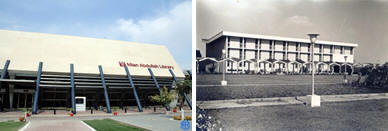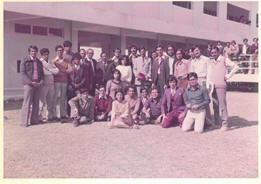"A Labour of Love"

Sibtain Naqvi, Author of "Chronicling Excellence: A History of IBA", reflects on the bitter-sweet journey of penning down the vast history of his alma mater.
Sibtain Naqvi is Head of University Relations at Habib University and Editor of Hum Khayal, the University magazine. An IBA graduate, he writes for several English publications on a range of subjects. His work has been cited in Through the Eyes of Tiger Cubs: Views of Asia's Next Generation by Mark L. Clifford and Janet Pau and co-sponsored by Time Magazine, Asia Business Council and the Lee Kuan Yew School of Public Policy at the National University of Singapore. He is the author of IBA's official history and currently engaged in research on Amroha and Sadequain.
1. What inspired you to pen down the history of IBA?
My
connection with the history book project started well
before I formally started working on the book. A few
years after graduating from the Institute of Business
Administration (IBA), I attended a memorial for one of
its leading lights, Mumtaz Saeed, known to our community
as "Bhai Shamman". A professor at the IBA in the '60s
and '70s, Bhai Shamman was a man known for his avuncular
charm and the memorial featured several of his
colleagues from the old days. After the service they got
together in a corner and started talking about the old
days of the institution, when they were students and
later young graduates themselves and had started
teaching there. The anecdotes painted a world of foreign
professors, student trips to northern areas and much
more. Many family members had studied from there or had
aspirations to and I had grown up with tales of the IBA:
the teachers, the discipline, the selection process,
etc. As a student I had been curious about the
Institution's past. While I was studying there the Prime
Minister of Pakistan was a IBA alumnus and visited on a

My second stint started when in October 2013 I got a
portentous call from Dr. Framji Minwalla whose exact
words were, and I can still recall them, "How busy are
you"? I told him quite a bit but one doesn't say no to
academics and specially those who happen to be friends
and especially when it's a chance to serve the
institution. Framji and Prof Sardar asked me to submit a
proposal which was approved and so began the second part
of my life at IBA. I was to write the history of IBA. I
was very well aware that there was the IBA of 1960s and
the IBA of later years and the dichotomy was jarring.
But here's the interesting bit. If my student experience
had been jarring for various reasons to do with faculty,
academics and facilities the second one was only because
of how far IBA had come from when I was a student.
2. How is IBA different now from the time that you
were a student here?

That IBA contrasts with what IBA is today and they
contrasted with what IBA was meant to be. It's not just
the physical infrastructure which is instantly obvious
but the intangibles: the vibrant intellectual fabric and
spirit of critical enquiry that infuses the faculty and
students. I cannot cover these aspects in a short time,
the book shall do that but suffice to say: IBA is now
the institution that was dreamt by its fathers, dreamt
by Dr Hoffman, its first head, and Dr Mukhtar, its first
Director.
3. Give us a sneak-peek into the book.

The book is divided into broad themes, at once
interconnected and distinct. Instead of a chronological
segmentation it was structured so to give each chapter
requisite space and allow the reader to go deep into the
different aspects of IBA: background, early days,
international linkages, infrastructure and facilities,
academic strength, faculty, student life and governance.
While the book as a whole is written keeping in mind the
general audience, it is expected that specific bodies of
readers will find certain chapters to be of particular
relevance.

4. How was your experience of writing the book?

In the end it came down to it simply being a labor of
love and how I wanted to showcase IBA, its successes and
challenges, highs and lows and explore a most remarkable
institution, one that is sometimes taken by granted even
by those who know it well. IBA is a unique institution,
the first business school outside of North America. No
single institution in the world has impacted the
corporate and business world of the country it is
located in the way IBA has done for Pakistan. It would
be fair to say that the history of Pakistan's economics
is inexorably tied with the history of IBA. And it's not
just the world of commerce that IBA heavily influenced.
Shortly after inauguration it was providing trainings
and refresher courses for the armed forces, government
functionaries and bureaucrats. Its influence spreads
into the very highest government posts in Pakistan. In
spite of being purely a business school for majority of
its years and with small annual student outputs, IBA was
able to produce graduates that served as ministers and
senators in different governments.
The book then is meant to chart the journey of an
institution that has shaped the corporate world of
Pakistan, produced national leaders and senior
academics. It also brings to light the lives and
experiences of those who made it what it is: the
faculty, the staff and the students. It did so in
troubled times and halcyon days and over 6 decades
maintained the quality of graduates and its standing
while other public institutions crumbled and decayed.
|
Related Links |
|
Take a sneak peek into the new IBA. View how your beloved institution has transformed leaps and bounds in recent years. |
|
Send us your request and we'll deliver your card. |
|
A hassle-free entry to campuses, access to on-campus facilities and offers from renowned companies. |
|
Featured Interviews
|